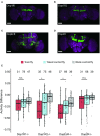Anti-instinctive Learning Behavior Revealed by Locomotion-Triggered Mild Heat Stress in Drosophila
- PMID: 32372923
- PMCID: PMC7179688
- DOI: 10.3389/fnbeh.2020.00041
Anti-instinctive Learning Behavior Revealed by Locomotion-Triggered Mild Heat Stress in Drosophila
Abstract
Anti-instinctive learning, an ability to modify an animal's innate behaviors in ways that go against one's innate tendency, can confer great evolutionary advantages to animals and enable them to better adapt to the changing environment. Yet, our understanding of anti-instinctive learning and its underlying mechanisms is still limited. In this work, we describe a new anti-instinctive learning behavior of fruit flies. This learning paradigm requires the fruit fly to respond to a recurring, aversive, mild heat stress by modifying its innate locomotion behavior. We found that experiencing movement-triggered mild heat stress repeatedly significantly reduced walking activity in wild type fruit flies, indicating that fruit flies are capable of anti-instinctive learning. We also report that such learning ability is reduced in dopamine 1-like receptor 1 (Dop1R1) null mutant and dopamine 2-like receptor (Dop2R) null mutant flies, suggesting that these two dopamine receptors are involved in mediating anti-instinctive learning in flies.
Keywords: Drosophila; dopamine receptors; learning; operant conditioning; stress.
Copyright © 2020 Sun, Delly, Sereno, Wong, Chen, Wang, Huang and Greenspan.
Figures





Similar articles
-
Visually Guided Behavior and Optogenetically Induced Learning in Head-Fixed Flies Exploring a Virtual Landscape.Curr Biol. 2019 May 20;29(10):1647-1659.e8. doi: 10.1016/j.cub.2019.04.033. Epub 2019 May 2. Curr Biol. 2019. PMID: 31056392
-
A place learning assay for tethered walking Drosophila.J Neurosci Methods. 2022 Aug 1;378:109657. doi: 10.1016/j.jneumeth.2022.109657. Epub 2022 Jun 26. J Neurosci Methods. 2022. PMID: 35760146
-
Dop1R1, a type 1 dopaminergic receptor expressed in Mushroom Bodies, modulates Drosophila larval locomotion.PLoS One. 2020 Feb 26;15(2):e0229671. doi: 10.1371/journal.pone.0229671. eCollection 2020. PLoS One. 2020. PMID: 32101569 Free PMC article.
-
Roles of Octopamine and Dopamine Neurons for Mediating Appetitive and Aversive Signals in Pavlovian Conditioning in Crickets.Front Physiol. 2017 Dec 12;8:1027. doi: 10.3389/fphys.2017.01027. eCollection 2017. Front Physiol. 2017. PMID: 29311961 Free PMC article. Review.
-
State-dependent plasticity of innate behavior in fruit flies.Curr Opin Neurobiol. 2019 Feb;54:60-65. doi: 10.1016/j.conb.2018.08.014. Epub 2018 Sep 13. Curr Opin Neurobiol. 2019. PMID: 30219668 Review.
Cited by
-
Diverse memory paradigms in Drosophila reveal diverse neural mechanisms.Learn Mem. 2024 Jun 11;31(5):a053810. doi: 10.1101/lm.053810.123. Print 2024 May. Learn Mem. 2024. PMID: 38862165 Free PMC article. Review.
-
High-throughput automated methods for classical and operant conditioning of Drosophila larvae.Elife. 2022 Oct 28;11:e70015. doi: 10.7554/eLife.70015. Elife. 2022. PMID: 36305588 Free PMC article.
-
Hard limits to cognitive flexibility: ants can learn to ignore but not avoid pheromone trails.J Exp Biol. 2021 Jun 1;224(11):jeb242454. doi: 10.1242/jeb.242454. Epub 2021 Jun 4. J Exp Biol. 2021. PMID: 34086906 Free PMC article.
-
Dopamine modulation of sensory processing and adaptive behavior in flies.Cell Tissue Res. 2021 Jan;383(1):207-225. doi: 10.1007/s00441-020-03371-x. Epub 2021 Jan 30. Cell Tissue Res. 2021. PMID: 33515291 Free PMC article. Review.
-
Identification and Expression Analysis of G Protein-Coupled Receptors in the Miridae Insect Apolygus lucorum.Front Endocrinol (Lausanne). 2021 Nov 26;12:773669. doi: 10.3389/fendo.2021.773669. eCollection 2021. Front Endocrinol (Lausanne). 2021. PMID: 34899608 Free PMC article.
References
-
- Balleine B. W., Daw N. D., Doherty J. P. O. (2009). Multiple forms of value learning and the function of dopamine BT - neuroeconomics: decision making and the brain, in Neuroeconomics Decision Making and the Brain, eds Glimcher P. W., Fehr E., Camerer C., Poldrack R. (London, UK; San Diego, CA; Burlington, MA: Elsevier Inc.), 538 10.1016/B978-0-12-374176-9.00024-5 - DOI
LinkOut - more resources
Full Text Sources
Molecular Biology Databases

